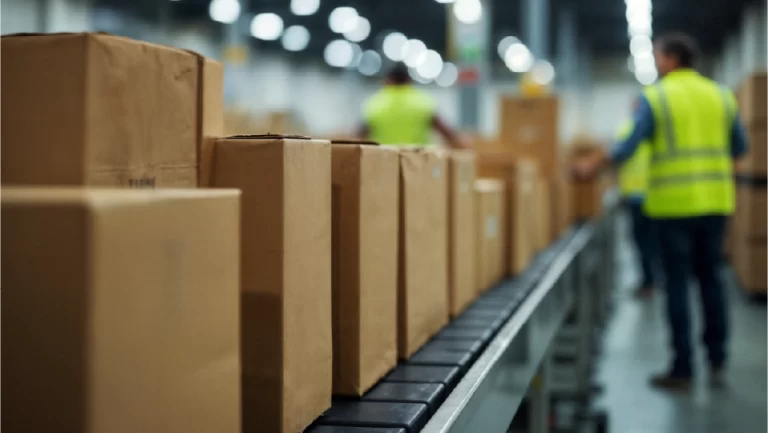In the industrial world, the conveyor belt is much more than just a tool for moving materials.It is the heart of production processes in sectors such as mining, construction, agriculture, and the food industry. Its efficiency, strength, and durability largely depend on a factor that is often overlooked: the technical fabrics that make up its internal structure.
In this article, we’ll dive into how technical fabrics directly impact the durability and maintenance of the conveyor belt, the factors that determine its performance, and the best practices to extend its lifespan.
The importance of technical fabrics in a conveyor belt
When we think of a conveyor belt, the first image that comes to mind is its outer surface. However, its true strength lies in the internal “skeleton” that gives it resistance, flexibility, and support: the technical fabric.
These fabrics act as the reinforcement that withstands the weight of the material, the movement tensions, and extreme working conditions. They are manufactured with high-performance fibers such as polyester, nylon, aramid, or hybrid combinations, depending on the type of application and the demands of each industry.
For example:
- In mining, ultra-resistant fabrics are required to withstand abrasion and heavy loads.
- In food, fabrics must meet sanitary standards and resist chemical exposure.
- In agriculture, flexibility and resistance to changing environmental conditions are key.
Without these fabrics, the conveyor belt would lose its shape, deform quickly, and drastically shorten its service life.
Factors that affect the durability of a conveyor belt
The lifespan of a conveyor belt does not depend solely on the type of technical fabric it contains. Other factors also affect its performance and maintenance:
1. Type of material transported
Abrasive, wet, or irregularly shaped materials cause greater wear on both the surface and internal structure of the belt.
2. Environmental conditions
Exposure to extreme temperatures, humidity, oils, or chemicals can damage fabrics if they’re not designed to withstand them.
3. Speed and workload
Excessive tension and speed increase stress on the fabric, causing elongation or even premature breakage.
4. Installation and alignment
Incorrect installation or poor alignment can lead to tears or uneven wear.
5. Preventive maintenance
Lack of periodic inspections can allow small damages to turn into major failures.
How technical fabrics extend the lifespan of the conveyor belt
Modern technical fabrics have evolved to meet the needs of each industry, providing key benefits for the durability of the conveyor belt. Some of the most important include:
1. High tensile strength
Polyester or aramid fabrics can withstand extreme loads without losing shape, preventing elongation that shortens lifespan.
2. Greater flexibility
Fabric flexibility allows the conveyor belt to adapt better to rollers and loading systems, reducing stress on joints.
3. Chemical and thermal resistance
In environments with high temperatures or chemical exposure, specialized technical fabrics act as a protective barrier against premature wear.
4. Reduced corrective maintenance
Being more resistant, these fabrics minimize downtime due to repairs, resulting in more efficient processes and lower operating costs.
Best maintenance practices to extend durability
No matter how advanced the technical fabrics in a conveyor belt may be, without proper maintenance, its lifespan will be compromised. Here are some key tips to maximize performance:
1. Regular inspections
Conduct weekly checks to identify wear, cuts, or alignment issues before they turn into major failures.
2. Routine cleaning
Dust, residues, and accumulated oils can affect both the fabric and the joints. Keeping the surface clean is essential, especially in food or chemical industries.
3. Proper tension adjustment
Inadequate tension causes excessive wear. Adjusting to the manufacturer’s recommended levels significantly extends lifespan.
4. Staff training
Operators should understand how the belt works and how to spot early issues. A trained eye is often the best detector of failures.
5. Use of original and compatible parts
When replacing components, using original or certified parts ensures the internal fabric structure is not compromised by incompatibility.
Innovations in technical fabrics for the conveyor belt
Industrial textile technology has advanced significantly, and today the conveyor belt can be manufactured with fabrics offering enhanced features:
- Hybrid fabrics: combinations of polyester and nylon that balance strength and flexibility.
- Aramid fibers: ideal for high-performance, heat-resistant applications.
- Special treatments: such as antistatic coatings, flame-retardant finishes, or resistance to aggressive chemicals.
- Lighter designs: reducing energy consumption when moving the belt without compromising strength.
These advancements not only extend the lifespan of the conveyor belt but also improve its efficiency and reduce long-term operating costs.
The conveyor belt is a key element in multiple industries, and its durability depends directly on the technical fabrics that form its structure. Choosing the right fabric for each application, combined with a preventive maintenance program, not only ensures greater strength and performance but also optimizes operating costs.
In a market that demands more efficient and sustainable processes, investing in innovative fabric technologies for the conveyor belt is no longer optional, it’s essential.
Additionally, having a reliable supplier of technical fabrics is crucial to ensure the performance and durability of the conveyor belt. Not all fabrics are designed for the same operating conditions, so working with specialists who understand each industry’s needs guarantees accurate selection and tailored solutions.
This synergy between material quality, manufacturing technology, and technical guidance helps maximize investment, minimize unplanned downtime, and maintain long-term process efficiency.



